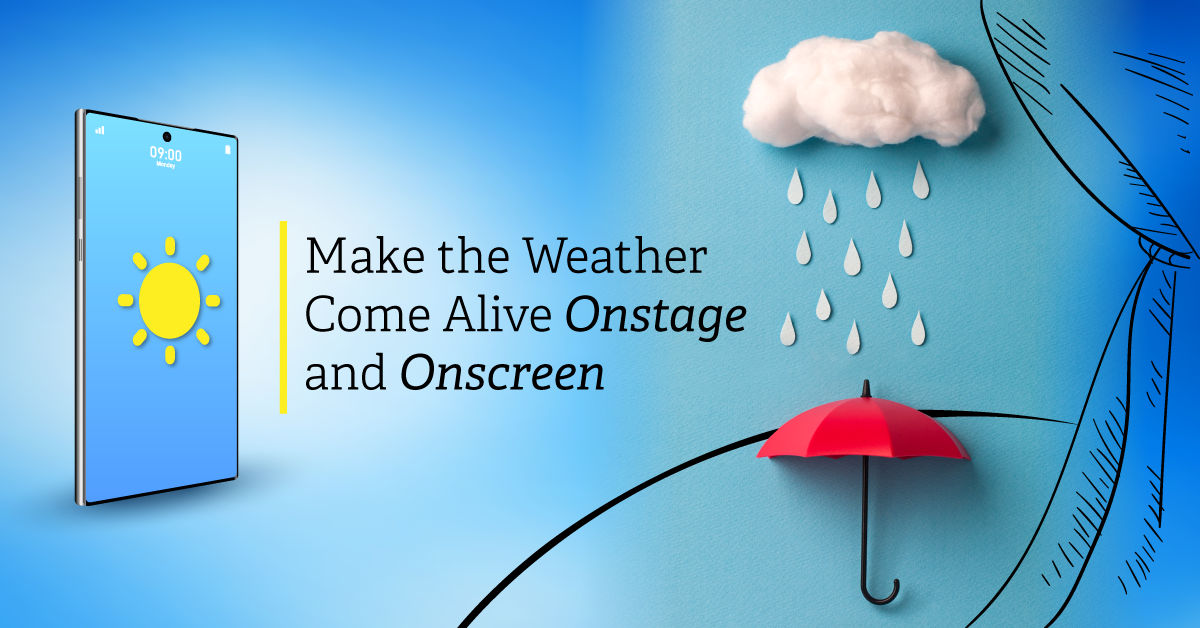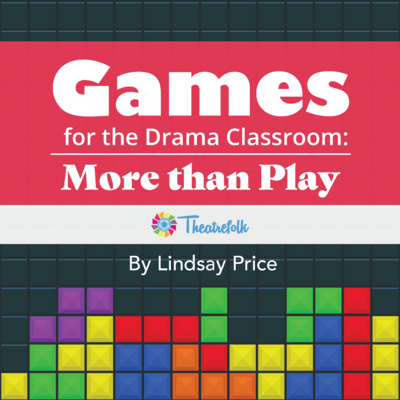Make the Weather Come Alive Onstage and Onscreen
Unless you have perfect timing, when you’re producing a show with your students, you will be performing it at a different time of year than what the show is set in. For example, you might be performing Almost, Maine in April (when the show is set in the winter) or Disney’s High School Musical 2 in February (when the show is about summer vacation). Even if it’s snowing inside, you’ll need to make the audience feel as though they’ve entered a tropical destination (or vice versa).
So, how do you make different types of weather come alive, either onstage or onscreen? Lots of different ways! Let’s explore them with your students.
The Rain Game
This is a fun game that the whole class can do, in person (at a distance if needed) or online (mics on — video optional). The class will work together to make a soundscape of rain sounds. No talking allowed!
The teacher will lead and the students will follow by watching and listening. Start with the full class gently rubbing their hands together, to mimic the wind. Slowly transition to tapping one finger on the palm of your hand. Add all four fingers, then move to gentle finger snapping, representing the pitter-patter of raindrops. The rain will get heavier as the class moves towards clapping, then a full out thunderstorm with stomping feet on the floor or slapping the floor with your hands. Then, move back through the actions in reverse as the storm goes away and the rain gets lighter and lighter. Ask your students: How could a soundscape like this be used to create atmosphere in a scene? What other sounds or actions could be included?
Technical Elements
There are lots of ways students can use technical elements to show the weather in their performances, including:
- Costumes: snow suits, bathing suits, rain coats, mittens, gloves, hats
- Props: umbrellas, beach toys, a bottle of sunscreen, seasonal sports equipment
- Set/virtual set: an appropriate virtual background when performing online, or set décor elements such as fake snow, a beach towel, leaves, flowers, a backdrop of a tree (such as a palm tree in the summer or an evergreen in the winter) or a blue sparkly curtain to represent rain
- Lighting: warm tones (yellows, reds, oranges) or strong spotlight for warm weather, cool tones (blues, purples) for cold weather
- Sound effects: wind whistling, rain sounds, birds chirping (from a sound effects library or real-life sound effects using tricks such as a rain stick and a metal sheet for rain and thunder, or the soundscape from earlier)
- Underscoring/background music: Beach Boys music to depict summer, or the song “Snow” from the musical White Christmas to represent a wintery scene
Distance Learning Quick Challenge: Give your students four minutes to find four different “things” around their home they could use to represent each of the four seasons. For example, they might grab a pair of rubber boots to represent a rainy spring, the song “Summer Nights” from Grease to represent hot summer weather, a rake to represent raking leaves in autumn, and a GIF of a snowstorm for a virtual background image to represent winter. (Feel free to adapt as appropriate to your local climate and weather trends!)
Performance Techniques
Of course, students don’t even need any technical elements to depict the weather; they can demonstrate or react to weather through performance techniques. Try the following prompts with your students:
Physical Acting** :** Have students mime the actions that match the weather.
- Cold weather: shivering, hugging themselves, burrowing into their clothes, catching snowflakes on their tongues
- Rain: holding their hands over their head, scrunching up their faces, wiping away “drops” of rain from their faces
- Hot weather: fanning themselves, applying sunscreen, sunbathing, jumping in a pool to cool off, wiping away sweat
- Wind: struggling to move against the wind, trying to keep items from flying away (such as a hat or papers)
Voice Only: Give students a short line to say while trying the following vocal techniques, such as, “Isn’t this weather something else?”
- Cold weather: teeth chattering, stuffy nose
- Hot weather: panting, taking a sip of a cool drink
- Windy or thunderstorm: trying to be heard over the “noise” of the weather (students can increase their intensity depending on the “intensity” of the weather — for example, a light breeze versus a hurricane)
Once students have practiced the two separate techniques (physical and vocal), have them combine physical actions with vocal techniques to create a mini solo scene. Have them start with the line, “Isn’t this weather something else?” and then improvise two more sentences to follow up.
Extension Challenge: Have students combine physical actions, vocal techniques, and at least one technical element to make a mini performance. Start with, “Isn’t this weather something else?” and write or improvise four additional lines, interacting with their technical element in some way. You may wish for students to perform live, or to record their performances and submit them to you. Have students present their mini performances for the rest of the class.
Related Articles
Create Your Own Choice Board: Drama Activities
by Lindsay Price
Choice boards give students the opportunity to choose how they want to learn a particular subject. Create Your Own Choice Boards: Drama Activities can help encourage your students' independence by allowing them to take an active role in their learning.
Distance Learning
by Christian Kiley
A play about trying to survive and thrive in a virtual classroom.
Games for the Drama Classroom: More Than Play
by Lindsay Price
A collection of games and activities that go well beyond the notion of "play."
Improv Games with Purpose
by Jennine Profeta
Improv games including feedback suggestions and questions, game variations, teaching tips, side coaching tips, entry prompts, exit slip questions, and more!







